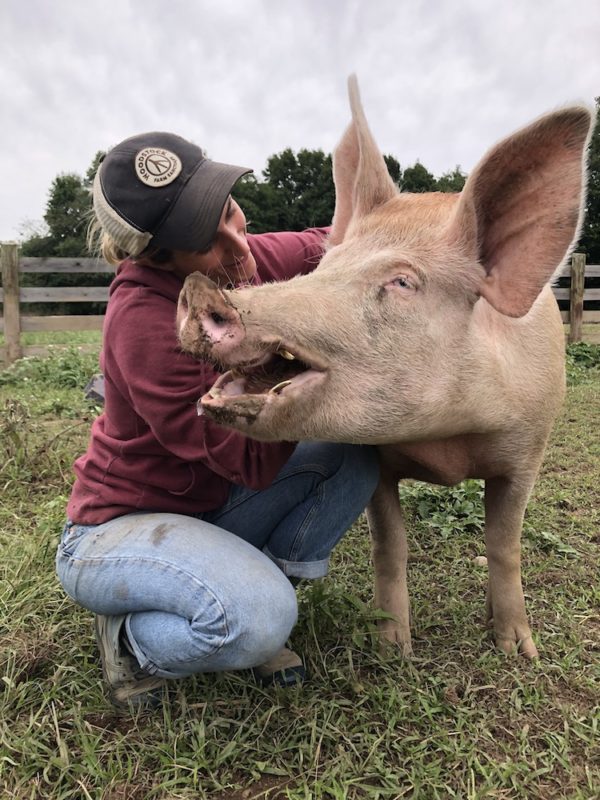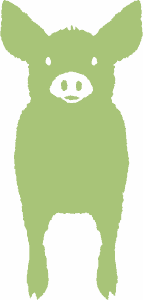
This resource was updated as part of the veterinary review process. It was originally published on May 19, 2022.

Veterinary Review Initiative
This resource has been reviewed for accuracy and clarity by a qualified Doctor of Veterinary Medicine with farmed animal sanctuaryAn animal sanctuary that primarily cares for rescued animals that were farmed by humans. experience as of June 2023.
Check out more information on our Veterinary Review Initiative here!
If you’ve spent much time looking through our offerings, you likely know the important role routine health checks play in keeping residents healthy and catching signs of concern early. Performing health checks regularly is imperative, but this should not be the only tool you use to monitor your residents’ health and well-being. The importance of thoughtful daily observation cannot be overstated. While some issues may be difficult to detect without a hands-on health evaluation, there are other potential signs of concern that could be missed during a health checkThe Open Sanctuary Project uses the term "health check" to describe health evaluations performed by caregivers who are not licensed veterinarians. While regular health checks are an important part of animal care, they are not meant to be a replacement for a physical exam performed by a licensed veterinarian., particularly those that manifest as slight changes in behavior or activity. By incorporating both daily observation and routine health checks into your care protocols, you are more likely to catch issues that develop in the period between health checks, as well as issues that are unlikely to be detected without a hands-on evaluation.
When it comes to daily observation, the keyword is “thoughtful”. Daily observation of residents must be more than just looking at them. Anyone caring for an animal, regardless of their species or breed, should be trained to observe the individuals in their care for behaviors and physical signs that are abnormal for the species, keeping in mind issues that are common in a particular species or breed and their warning signs. Of equal importance is getting to know the individuals being cared for and watching for things that are out of the ordinary for that particular individual. To read more about refining your observation skills, check out our resource here.
Familiarize Yourself With “Normal”
In order to identify signs of concern, it’s helpful to first consider how a healthy pig typically looks and acts. While all pigs are unique individuals, there are some general characteristics that most healthy pigs will present. However, there is going to be some variation based on the individual’s breed and their unique characteristics, so it’s also important to learn what is “normal” for each individual in your care.

With that in mind, in general, a healthy pig should:
- Be bright and alert, though they do take naps throughout the day and may spend quite a bit of time in bed when the weather is cold
- Have clear, bright, open eyes (pigs who are overweight will often have rolls of skin and fat covering their eyes, which will be their “normal” until they lose weight)
- Have erect ears unless floppy ears are typical for a particular breed/individual
- Walk with an even gaitA specific way of moving and the rhythmic patterns of hooves and legs. Gaits are natural (walking, trotting, galloping) or acquired meaning humans have had a hand in changing their gaits for "sport".
- Stand and walk with a fairly straight back
- Have an even respiratory pattern with quiet breathing sounds
- Be excited to eat and finish their meals
- Have a relatively clean bum (unless they’ve been wallowing in the mud!)
- Urinate and defecate with ease and without signs of pain
- Have well-formed feces
- Appear generally symmetrical
Potential Signs Of Concern
Now that we’ve got an idea of what is “normal”, let’s look at potential signs of concern. Because every resident is an individual, it’s important to get to know the unique individuals in your care so you can recognize when they are not acting like themselves. Caregivers who really spend time getting to know their residents in terms of their personality, typical behaviors, physical characteristics, and routines can sometimes catch when something is wrong before there are clear signs of illness or distress. Sometimes it’s something as simple as an individual sleeping away from their friends or not waiting eagerly for breakfast in the morning as they usually do. Any time you notice a change in an individual’s normal routine, it’s a good idea to perform a health check and keep a close eye on them.
While not an exhaustive list, during your daily observation of your residents, be on the lookout for the following:
General signs of pain/discomfort such as…
- Tooth grinding
- Painful vocalizations
- Sensitivity to being touched (generally or in a specific area)
Changes in their posture, gait, mobility, or activity level such as…
- Limping, stiffness, dragging, weakness, or trying to keep weight off a particular limb
- “Dipping” (falling down on hind legs)
- Incoordination or circling
- Hunching their back, standing with legs closer or farther apart than normal, or sitting in an unusual position (such as “dog-sitting”)
- Sitting, lying down, or sleeping more than usual (activity level is often affected by the temperature, so it’s helpful to consider an individual’s activity level both in the context of what is typically normal for them and what their herd mates are doing)
- Head tilting
- Body tremors
Changes to their physical appearance such as…
- Swelling above the hoof and/or cracks in the hoof
- Skin changes such as lumps, lesions, scabbing, discoloration (in isolated patches or more generally), or oozing sores
- Changes in hair coat (they do shed, so hair loss is not always abnormal)
- Nasal or ocular discharge
- Squinting
- Vaginal discharge or prolapsethe falling down or slipping of a body part from its usual position or relations
- Rectal prolapse
- Weight loss or a loss of body condition
- Limp or floppy ears in a pig who typically has upright ears
- Swollen pinna(e)
Changes in behavior such as…
- Excessive scratching
- Constantly shaking their head
- Changes to their daily routine
- Avoiding or being rejected by herd mates
- Behaving differently than they normally do
Changes to their eating and drinking, such as…
- Dropping food
- Not finishing meals, eating more slowly, complete disinterest in food, or acting excited about food but then not actually eating
- Not drinking water or being excessively thirsty
Other things to watch for include…
- Open-mouth breathing, labored breathing, elevated respiratory rate (in general, a pig who is not stressed should have a respiratory rate of 15-50 breaths per minute), coughing, wheezing, or other abnormal breathing sounds
- Abnormal smell to their breath or body
- Vomiting or drooling (drooling while anticipating food is normal)
- Abnormal droppings such as diarrhea (a dirty rear could be a sign that the individual has diarrhea), bloody stool, dark-colored stool, worms in stool, or excessively hard stool
- Straining during urination or defecation
- Abnormal body temperature (in some cases, individuals may feel excessively warm or cool to the touch, or their extremities may feel cold). If you have concerns about a pig’s body temperature, you should take their rectal temperature. Different sources offer different normal temperature ranges for pigs. According to Merck Veterinary Manual, the normal range is 101.6-103.6 F (38.7-39.8 C), but some sources offer a lower range than this, particularly for mini pigThe term “mini pig” is used to categorize smaller breeds of pigs, such as Potbellies, Julianas, and Kunekunes, and to differentiate between these breeds and large breed pigs, such as Yorkshires, Landrace, or Hampshires, who are sometimes referred to as “farm pigs”. The descriptor “mini” can be a bit misleading- some breeds of mini pigs can weigh over 200 pounds! Terms like “teacup”, “micro”, “pocket”, “nano”, and “micro mini” are deceptive terms that are sometimes used to intentionally mislead people into thinking an individual pig will remain a certain size. breeds. Dr. Kristie Mozzachio provides a normal rectal temperature range of 99.7-102 F (37.6-38.9 C) for adult mini pigsThe term “mini pig” is used to categorize smaller breeds of pigs, such as Potbellies, Julianas, and Kunekunes, and to differentiate between these breeds and large breed pigs, such as Yorkshires, Landrace, or Hampshires, who are sometimes referred to as “farm pigs”. The descriptor “mini” can be a bit misleading- some breeds of mini pigs can weigh over 200 pounds! Terms like “teacup”, “micro”, “pocket”, “nano”, and “micro mini” are deceptive terms that are sometimes used to intentionally mislead people into thinking an individual pig will remain a certain size..
- Pale and/or dry gums
- Pale mucous membranes
- Flies swarming a particular area (which may be an indication of a wound)
If you see any of the signs above or anything else out of the ordinary, be sure to investigate further and consult with your veterinarian as needed. Depending on the severity and whether or not there are multiple signs of concern, the individual may need to be seen by a veterinarian immediately. In some cases, conducting a health check, either in full or in part, can help you to gather more information about the individual to share with your veterinarian so they can help determine the best course of action.
Now that you have an idea of what to look for, be sure to build thoughtful daily observation into your caregiving routine if you haven’t already! The more you observe your residents, the better you’ll become at differentiating between “normal” and potentially concerning. When in doubt, we recommend contacting your veterinarian for guidance.
Don’t Forget To Record Your Observations!
Consider using our Ongoing Treatment And Observation Record to record your daily observations!
SOURCES:
Basic Information Sheet: Miniature Pigs: Lafeber Vet








